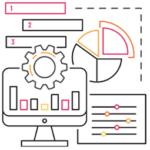The Cost of a SAFe® Implementation: Budgeting Tips to Help You Launch Your First Agile Release Train
In the past several years, I have worked with a number of clients who were interested in adopting SAFe (Scaled Agile Framework), but were concerned about the costs associated with this effort. The main source of this concern is the lack of experience and knowledge on how to apply SAFe successfully and in a cost-effective manner. Many of these clients have a preconceived notion that “SAFe is too expensive,” which is a very subjective data point that may or may not be true. If you are in a similar situation, you are in the right place. In this article, I will break down the costs associated with launching a basic ART (Agile Release Train) for an average-sized initiative. This will be a simple example that you can use as a starting point to develop a budget for your project based on your context and organizational needs and requirements.
Let’s start by taking a look at the SAFe Implementation Roadmap, which is the recommended approach for assembling and launching an ART. This graphic is very detailed so we will not be diving into every specific item here; instead, we will look at some of the key components that will influence your project budget.
Two Major Cost Components for Launching Your First ART
The cost associated with launching and running your ART consists of two major components: training and ongoing operations.
Training

Send every team member to a training class
This is likely the fastest (but the most costly) method for educating your entire project team in the shortest amount of time. If time is critical for your project, this may be the best option. Keep in mind that the average cost of a training class provided by an external training organization will be approximately $2,000 per class per participant. Also, some team members will likely need multiple courses, starting with the foundational class (i.e. Leading SAFe or SAFe for Teams), then go on to take a role-based class such as SAFe Scrum Master, SAFe Product Owner/Product Manager, or SAFe Release Train Engineer. For a team of 50 or so people, this cost may begin to seem non-trivial; the estimated cost for 1 class per person would come out to approximately $100,000.
Train team members to become trainers
You may be able to reduce the total cost for training by sending a few team members to Implementing SAFe class to acquire their SPC (SAFe Program Consultant) certification, which enables them to teach other SAFe classes (assuming they also take additional preparation workshops, called “Enablements”).
The cost for one SPC would be approximately $3,000 per class. However, if they can run training courses for the other team members, the cost for those participants would be $100 per person (for SAFe license). You will also need to account for supplies and materials for each course, which should be relatively small.
One risk to consider is the ability for this new SPC to deliver effective training; if the newly-minted SPC has limited or no direct experience applying SAFe successfully in a real-world project, the training may not be as useful. Also, be sure to keep in mind that delivering effective and engaging training is not a simple skill to learn; many professionals spend years developing and refining their skills to conduct training effectively, and it is not something that can be learned in a short period of time. This is especially true for virtual training courses where engaging participants is even more challenging.
Request a private training from a training provider
One final option to consider consists of a private training course given by an authorized training vendor. This option will generally cost approximately $10,000 to $20,000 per class, possibly more depending on the number of participants. This option will still be considerably less expensive as compared to individual team members attending the course.
Ongoing Operations – Labor Costs
In addition to training, the bulk of the costs associated with launching and operating an ART is centered around labor costs. Assuming you are able to assemble a team of dedicated staff for your train, you may be able to estimate the recurring cost for your train by doing simple estimates using some burden rate that your organization will likely already have. If you assume a $100 per hour average rate for your staff, one team member will cost $200,000 per year, or equivalent to four Program Increments (fully loaded, assuming 2,000 hours per year). This means that the cost of one Program Increment (4 months) would be $50,000 per person.
As a result, if we assume the train has 50 team members, that would come out to $10 million per year. Does that sound reasonable or realistic? That all depends on what numbers you are working with. Your average hourly rate may be higher or lower, and your ROI analysis will likely tell you whether this train is a worthy investment.
Other Benefits and Factors to Consider

Some trains may take years to realize the expected benefits, while others may see results in a much shorter period of time. Ultimately, you may need to look beyond the numbers, and find sufficient sponsorship to experiment with SAFe to see how this tool may work for your organization. That may be the optimal way to discover the best solution for you.


